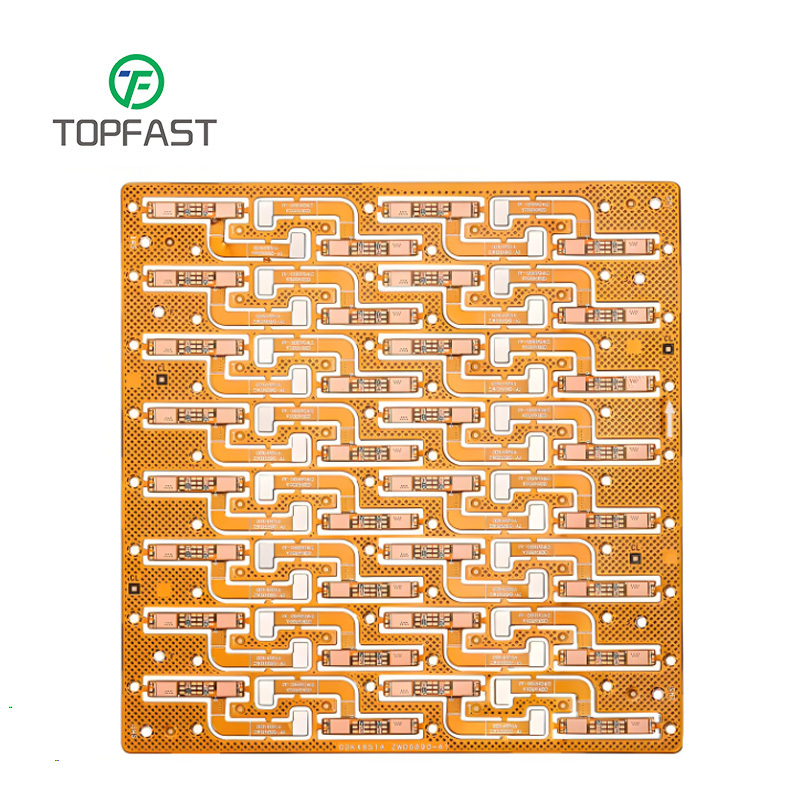Description
Product Overview
Multilayer Flexible Printed Circuit Boards (Multilayer FPCs) are high-performance interconnect components composed of alternating layers of flexible substrates and conductive copper. Compared to single/double-sided FPCs, multilayer FPCs enable more complex circuit designs through interlayer connections (e.g., laser drilling, plated through-holes), making them suitable for high-density, high-reliability electronic devices.
Multilayer FPCs are widely used in consumer electronics, automotive electronics, medical devices, aerospace, and 5G communications, meeting demands for miniaturization, lightweight design, and bendability.
Flexible PCB Parameters
| Item |
Flexible PCB |
| Max Layer |
8L |
| Inner Layer Min Trace/Space |
3/3mil |
| Out Layer Min Trace/Space |
3.5/4mil |
| Inner Layer Max Copper |
2oz |
| Out Layer Max Copper |
2oz |
| Min Mechanical Drilling |
0.1mm |
| Min Laser Drilling |
0.1mm |
| Aspect Ratio(Mechanical Drilling) |
10:1 |
| Aspect Ratio(Laser Drilling) |
/ |
| Press Fit Hole Ttolerance |
±0.05mm |
| PTH Tolerance |
±0.075mm |
| NPTH Tolerance |
±0.05mm |
| Countersink Tolerance |
±0.15mm |
| Board Thickness |
0.1-0.5mm |
| Board Thickness Tolerance(<1.0mm) |
±0.05mm |
| Board Thickness Tolerance(≥1.0mm) |
/ |
| Impedance Tolerance |
Single-Ended:±5Ω(≤50Ω),±10%(>50Ω) |
| Differential:±5Ω(≤50Ω),±10%(>50Ω) |
| Min Board Size |
5*10mm |
| Max Board Size |
9*14inch |
| Contour Tolerance |
±0.05mm |
| Min BGA |
7mil |
| Min SMT |
7*10mil |
| Surface Treatment |
ENIG,Gold Finger,Immersion Silver,Immersion Tin,HASL(LF),OSP,ENEPIG,Flash Gold;Hard gold plating |
| Solder Mask |
Green Solder Mask/Black PI/Yellow PI |
| Min Solder Mask Clearance |
3mil |
| Min Solder Mask Dam |
8mil |
| Legend |
White,Black,Red,Yellow |
| Min Legend Width/Height |
4/23mil |
| Strain Fillet Width |
1.5+0.5mil |
| Bow & Twist |
/ |

Product Features
-
High-Density Wiring
-
Utilizes fine-line technology (line width/spacing as low as 30/30μm) and blind/buried vias to enhance circuit integration.
-
Suitable for chip-scale packaging (CSP), high-pin-count BGAs, and other precision components.
-
Excellent Flexibility
-
Uses polyimide (PI) or liquid crystal polymer (LCP) substrates, allowing repeated bending (dynamic applications can withstand millions of cycles).
-
Supports 3D installation, adapting to complex spatial layouts.
-
High Reliability and Stability
-
Resistant to high temperatures (PI substrates can withstand reflow soldering above 260°C) and chemical corrosion.
-
Low dielectric loss, ideal for high-frequency and high-speed signal transmission (e.g., 5G mmWave).
-
Lightweight and Thin Design
-
Thickness can be controlled below 0.1mm, weighing over 70% less than rigid PCBs.
-
Suitable for weight-sensitive applications such as wearables and foldable smartphones.
Product Advantages
| Comparison |
Multilayer FPC |
Traditional Rigid PCB |
Single/Double-Sided FPC |
| Flexibility |
Excellent (dynamic bending) |
None |
Good (static bending) |
| Wiring Density |
Very high (multilayer interconnects) |
High |
Moderate |
| Weight |
Extremely light |
Heavy |
Light |
| High-Frequency Performance |
Excellent (LCP substrate) |
Good |
Average |
| Cost |
Higher (complex process) |
Low |
Moderate |
Manufacturing Process
Multilayer FPC production is more complex than standard PCBs, with critical processes including:
-
Material Preparation
-
Inner Layer Patterning
-
Lamination and Through-Hole Plating
-
Surface Treatment
-
Testing and Validation
-
Flying probe testing (electrical performance)
-
Bend cycle testing (dynamic applications require ≥100,000 cycles)
Applications
-
Consumer Electronics
-
Automotive Electronics
-
Medical Devices
-
Industrial & Communications
-
Aerospace

Frequently Asked Questions (FAQ)
Q1: What file formats do you accept for PCB manufacturing?
We support all industry-standard formats, including:
– Gerber (RS-274X)
– PROTEL (99SE & DXP)
– CAM350
– ODB++ (.TGZ)
– Eagle
– Altium Designer
– PADS
Q2: How do you protect my design files and intellectual property?
We take data security extremely seriously. Your design files are:
– Stored on encrypted servers
– Only accessible to your dedicated project team
– Never shared with third parties without your explicit written consent
– Automatically purged after project completion (unless otherwise requested)
Q3: What payment methods do you accept?
We offer flexible payment options:
Electronic Payments:
– PayPal
– AliPay
– Credit Cards (Visa/MasterCard/UnionPay)
Bank Transfers:
– T/T (Telegraphic Transfer)
– Western Union
– L/C (Letter of Credit)
Q4: What are your shipping options?
We provide global logistics solutions:
Express Shipping (1-5 days):
– DHL
– FedEx
– UPS
– EMS
Bulk Shipping:
– Air freight (>300kg)
– Sea freight (Full container options)
– Can accommodate your preferred freight forwarder
Q5: What is your minimum order quantity?
We specialize in both:
– Prototype quantities (1 piece available)
– High-volume production
No minimum order value requirements
Q6: Can we visit your manufacturing facilities?
We welcome client visits to our facilities:
Main Facility:
Shenzhen, China (ISO 9001 certified)
Secondary Facility:
Guangdong Province, China
Please contact us to schedule a tour with our engineering team
Q7: How do you guarantee PCB quality?
Our comprehensive quality assurance includes:
Testing:
– 100% Electrical Testing (Flying Probe & E-Test)
– Automated Optical Inspection (AOI)
Certifications:
– IPC Class 2/3 standards
– ISO 9001:2015 certified
– UL certified (upon request)
Additional Services:
– Free DFM analysis
– 3D model verification
– Cross-section analysis available
All PCBs come with our quality guarantee and full traceability documentation.